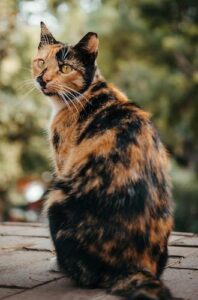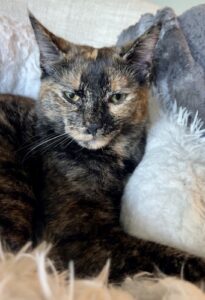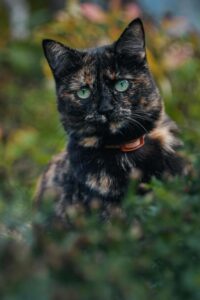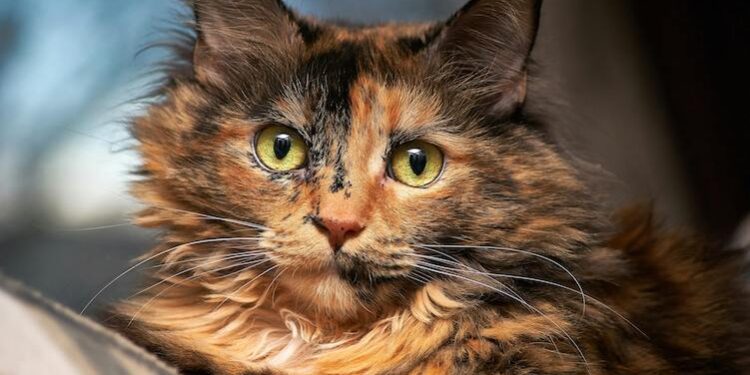 Tortoiseshell does not refer to a specific cat breed but to a beautiful, multi-colored coat pattern with a similar structure and color scheme to that of a tortoise’s shell. It comes in many color variations but primarily consists of ginger and black with white, orange, gold, or cream touches. Many people mistake tortoiseshell cats with calico cats because their coat patterns are similar. The calico pattern, however, has a white fur base with patches of orange and black. Sometimes, patches can be cream or grey – a pattern known as a muted calico.
Tortoiseshell does not refer to a specific cat breed but to a beautiful, multi-colored coat pattern with a similar structure and color scheme to that of a tortoise’s shell. It comes in many color variations but primarily consists of ginger and black with white, orange, gold, or cream touches. Many people mistake tortoiseshell cats with calico cats because their coat patterns are similar. The calico pattern, however, has a white fur base with patches of orange and black. Sometimes, patches can be cream or grey – a pattern known as a muted calico.
Both tortoiseshell and calico markings appear in domestic cats of different breeds, as well as in non-purebred cats, and most of them will be female. It takes two X chromosomes to produce the tortoiseshell and calico coat patterns. Each X chromosome has one color attached to it, which makes the distinctive mix of colors possible. Tortoiseshell and calico males are therefore only seen in rare cases of genetic mutation, for instance when a male cat is born with two X chromosomes. This is called Klinefelter syndrome, and males with the XXY chromosome combination are usually sterile.
 A tortoiseshell cat, or tortie, can have a patched or brindled coat pattern. The pattern is patched if the colors appear in larger sections all over the body, but it is brindled if the colors appear blended or mixed. We also have tortoiseshell cats with tabby stripes, known as torbies, and torties with a chimera appearance. Chimera is a distinctive coat pattern where the cat’s body is divided into two color halves: the cat will have one color on one side of the body and a different color on the other. It usually manifests as a half-black/half-ginger face with an almost symmetrical line running down the nose, but the division in color can differ and occur all over the body. With regards to eye color, there is not one specific color associated with tortoiseshell cats. They typically have either hazel, amber, or green eyes.
A tortoiseshell cat, or tortie, can have a patched or brindled coat pattern. The pattern is patched if the colors appear in larger sections all over the body, but it is brindled if the colors appear blended or mixed. We also have tortoiseshell cats with tabby stripes, known as torbies, and torties with a chimera appearance. Chimera is a distinctive coat pattern where the cat’s body is divided into two color halves: the cat will have one color on one side of the body and a different color on the other. It usually manifests as a half-black/half-ginger face with an almost symmetrical line running down the nose, but the division in color can differ and occur all over the body. With regards to eye color, there is not one specific color associated with tortoiseshell cats. They typically have either hazel, amber, or green eyes.
Myths and stories about torties have existed since ancient times, and cultures around the world link them with things such as luck and good fortune. In Japan, they are believed to protect ships from bad storms and homes from ghosts and evil spirits. In Ireland, Scotland, and Germany, they are seen as omens of wealth and prosperity. Settlers brought these beliefs to America, where torties are now nicknamed money cats. Folklore examples also include a Turkish myth about a wizard, who created the tortoiseshell coat pattern by using different-colored smoke. Similarly,  Khmers in Cambodia believed the origin of the unique pattern was the blood of a lotus flower goddess. Other stories describe how the golden tortie color stems from the sun and was a gift to a black cat from a solar deity.
Khmers in Cambodia believed the origin of the unique pattern was the blood of a lotus flower goddess. Other stories describe how the golden tortie color stems from the sun and was a gift to a black cat from a solar deity.
Tortoiseshell cats are known for being sassy, vocal, and headstrong – personality traits that can manifest themselves as an increased tendency to bite, scratch, or hiss at human or animal companions. Cat behaviorists sometimes call this diva disposition tortitude, but it should not prevent you from adopting a tortoiseshell cat. They may be stubborn little ladies, but they are also fiercely loyal and often form strong, lasting, loving bonds with their preferred humans.




